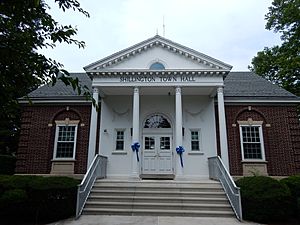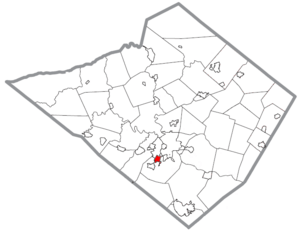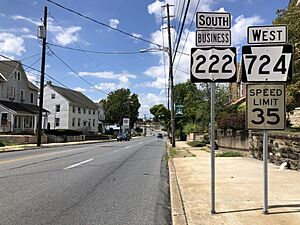Shillington, Pennsylvania facts for kids
Quick facts for kids
Shillington, Pennsylvania
|
|
|---|---|

Shillington Town Hall
|
|
| Nickname(s):
"The Town Beautiful"
|
|

Location of Shillington in Berks County, Pennsylvania
|
|
| Country | United States |
| State | Pennsylvania |
| County | Berks |
| Area | |
| • Total | 1.00 sq mi (2.60 km2) |
| • Land | 1.00 sq mi (2.59 km2) |
| • Water | 0.01 sq mi (0.01 km2) |
| Elevation | 354 ft (108 m) |
| Population
(2020)
|
|
| • Total | 5,475 |
| • Estimate
(2019)
|
5,319 |
| • Density | 5,324.32/sq mi (2,055.27/km2) |
| Time zone | UTC-5 (EST) |
| • Summer (DST) | UTC-4 (EDT) |
| ZIP Code |
19607
|
| Area code(s) | 610 and 484 |
| FIPS code | 42-70248 |
Shillington is a small town, also called a borough, located in Berks County, Pennsylvania, United States. In 2020, about 5,475 people lived here. This town is close to Reading and is known for a few cool things. It was once home to Thomas Mifflin, who was Pennsylvania's very first governor! It's also the childhood home of a famous American writer, John Updike. Many of his stories are set in a made-up town called Olinger, which is actually Shillington in disguise.
Contents
The Story of Shillington
Shillington started way back in 1860. A local landowner named Samuel Shilling began selling parts of his land for homes. That's how the town got its name!
Early Days and Growth
An old inn, built in 1762, was a popular spot in the area. It was called the Three Mile House because it was 3 miles from Reading. Farmers often stopped there on their way to the city markets. Later, a horse racing track was built nearby in 1868.
In 1884, Shillington got its own post office. This was a big step for the growing community. On August 18, 1908, Shillington officially became a separate town, or borough. It had about 450 people then. Later that year, Adam Rollman was elected as the first leader, called a chief burgess. The town's government meetings were held in different places until the current town hall was finished in 1932.
Angelica Farm and Its Legacy
A large part of Shillington used to be Angelica Farm. In 1824, this farm became an "almshouse" or "poorhouse." This was a place where people who couldn't support themselves could live and get help. In 1952, a new facility replaced it.
Today, the land where the almshouse once stood is mostly taken up by the Governor Mifflin School District. You can still see a stone wall from the old poorhouse near John Updike's childhood home. John Updike even wrote a book called The Poorhouse Fair, which was inspired by Shillington's poorhouse. Many of his early stories were set in a fictional version of Shillington called Olinger. These stories were collected in a book called Olinger Stories.
Angelica Farm was also the historic home of Thomas Mifflin. He was a very important person, as he was the first governor of Pennsylvania. He was also the 11th President of the Continental Congress.
Education in Shillington
Shillington is home to the Governor Mifflin School District. This district serves students from Shillington and nearby areas.
Local Schools
Within Shillington Borough, there are two main schools:
- Governor Mifflin Senior High School
- Governor Mifflin Middle School
The school district also has other elementary schools in nearby Cumru Township and Brecknock Township.
Famous People from Shillington
Many interesting people have connections to Shillington:
- Kenny Brightbill: A well-known race car driver.
- Chip Kidd: A famous book designer.
- Thomas Mifflin: The first governor of Pennsylvania.
- John Updike: A celebrated author.
- Nicholas Singleton: A talented football player for Penn State.
Shillington's Location and Surroundings
Shillington is located in southeastern Pennsylvania. It's right next to Reading, which is the main city of the county. Shillington is about 60 miles northwest of Philadelphia.
Natural Features
Wyomissing Creek flows along the western edge of Shillington. This creek is a branch of the larger Schuylkill River. Most of Shillington is surrounded by Cumru Township. However, it also shares a border with Wyomissing to the northwest.
The United States Census Bureau says that Shillington covers about 1 square mile (2.5 square kilometers) in total. Only a very small part of this area, about 0.01 square miles, is water.
Shillington's Population Over Time
| Historical population | |||
|---|---|---|---|
| Census | Pop. | %± | |
| 1880 | 136 | — | |
| 1910 | 1,427 | — | |
| 1920 | 2,175 | 52.4% | |
| 1930 | 4,401 | 102.3% | |
| 1940 | 4,932 | 12.1% | |
| 1950 | 5,059 | 2.6% | |
| 1960 | 5,639 | 11.5% | |
| 1970 | 6,249 | 10.8% | |
| 1980 | 5,601 | −10.4% | |
| 1990 | 5,062 | −9.6% | |
| 2000 | 5,059 | −0.1% | |
| 2010 | 5,273 | 4.2% | |
| 2020 | 5,475 | 3.8% | |
| 2019 (est.) | 5,319 | 0.9% | |
| Sources: | |||
In 2000, there were 5,059 people living in Shillington. There were 2,238 households, which are groups of people living together. About 26.5% of these households had children under 18. The average household had 2.26 people.
The population was spread out by age. About 21.5% of the people were under 18. The median age, meaning the middle age of all residents, was 40 years old.
Getting Around Shillington
As of 2007, Shillington had about 19.67 miles of public roads. Some of these roads are kept up by the state's Department of Transportation (PennDOT). Most of the roads, about 17.52 miles, are taken care of by the borough itself.
Two important highways pass through Shillington. These are U.S. Route 222 Business and Pennsylvania Route 724. US 222 Business follows Lancaster Avenue, running from southwest to northeast. PA 724 also uses parts of Lancaster Avenue and Philadelphia Avenue. It runs from northwest to southeast, sometimes sharing the road with US 222 Business.
Images for kids
See also
 In Spanish: Shillington (Pensilvania) para niños
In Spanish: Shillington (Pensilvania) para niños








